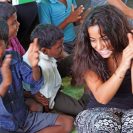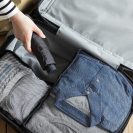Two Eid-ul-Adha’s ago, my husband and I decided to forgo our usual visit to his home country, for a trip to Lebanon. We want to see ruins and mountains and to discover the “Paris of the Middle East” while yet having access to halal food. With his visa in hand and my on-arrival visa, we find ourselves richer in memories.
Arrival
Fireworks spark up the mountains in celebration of the holiday on our descent towards Beirut-Rafic Hariri International Airport. We take a taxi past French and Venetian architecture on the way to our hotel. The taxi stalls: the driver restarts it at every signal, once mid-turn in an intersection. He flashes ten fingers. We hand him 10,000 pounds, not the $10 he demands while speeding away. An inspection of our room—complete with bidet and three kinds of breakfast—precedes a walk along Rue Hamra: neon stars and crescents marking the holiday, a student eating a sandwich on her way to the American University, peri-peri, a French-English-Arabic bookstore, a marked army presence in front of government buildings. People are so friendly they look us in the eyes, rather than down or past, as we walk by. We meet a tourist couple searching for a belly-dancing club, but can’t offer help. My husband gets a Nescafe from a service station. At a fruit shop we buy persimmons, local and in season, to eat with breakfast.
First Day
Our concierge recommends we save pounds and time by hiring a hotel-approved private taxi instead of buying tour bus packages. Our driver cruises in the mist north along the coast to the Jeita Grotto near Jounieh. Signboards urge us to vote for the caves as one of the New Seven Wonders of the World. In the grottos, water drips off stalactites onto our hair. Some formations look like waxen mushrooms, others jellyfish, or even curtains.
We spend a rainy afternoon riding the Teleferique from the sea to the top of a hill toward the statue of Our Lady of Lebanon in Harissa, a predominantly Christian area.
The evening brings us to Byblos, one of the oldest continuously populated cities of the world, where ruins of a Crusader castle, Ottoman mosque, old souk, and outdoor cafes coexist in time.
Second Day
A drive inland leads us to the Caves de Ksara, a winery built in one of Lebanon’s natural caves. Other tourists sample the wares, many from grapes sourced from Europe. My husband has another Nescafe.
We drive through the Beqaa Valley. Sheep crawl like pixels on the mountains where gunshots ring—fowl-hunting, nothing more. At Baalbek, an ancient Roman temple complex, graffiti dated from the 1890s adorns the walls of the Temple of Bacchus, likely from the first waves of tourists to arrive when Lebanon was part of the Ottoman Empire. A stroll from the ruins takes us to the middle of the modern town, where we have shawarma at a busy intersection. Within the bounds of their residences, children chase each other with new toy guns.
The sun sets in indigo and gold near the ruins of the Umayyad palace-city in Anjar. Banners descry the Genocide from 1915 to 1923 near the large Armenian community nearby.
Third Day
The morning takes us south to the Moussa Museum, which houses displays of guns, silver jewelry, and knives. We travel toward Beiteddine to see the former Ottoman palace and current summer presidential residence. Instead of continuing south we drive deep in the opposite direction, crossing the Chouf Mountains, past banana groves, grape-covered cottages, and sanobar trees, toward the Barouk Cedar Reserve. Years of exploitation of Lebanon’s famous cedars have led to reforestation efforts. The forest is peaceful and dense with trees, many thousands of years old. No sunlight or sound penetrates the forest.
Before sunset we drive south toward Sidon, an ancient Phoenician coastal city. The boardwalk is crowded and lively this weekend. We snack on zaatar-stuffed bread and climb the Crusader castle near the fisheries.
Fourth Day
Today we explore Beirut. We walk along Manara Beach and to the cove so I can dip my hand in the Mediterranean, the farthest point west on our journey. Sleek like two fish, a father and son dive into the sea at Raouche, in the dissipating wake of a skiff taking tourists around the arches of the Pigeons’ Rock. Their tanned backs glisten in the sun.
In the afternoon we lunch on Neapolitan pizza, savoring Lebanon’s golden olive oil. At night we visit the Beirut Souks for shopping, a Maronite Church (an old Christian denomination originating here in the fourth century), the Al-Hariri Mosque, and the Place du Martyrs. Boys stare at a couple on a bench next to the ancient Roman baths. Interspersed in Beirut are the ruins of Roman columns, fenced off and preserved, standing alongside buildings being reconstructed post-war as the country, at a point of unstable equilibrium, pulses toward the future.
Departure
The customs officer checks my passport and wonders was my father perhaps Lebanese? I can’t help but love her for her friendly desire to claim me as one of her own. I don’t want to leave, but I can’t stay, and feel inspired to learn Arabic, wishing to take the accent I have been hearing for the past few days as a souvenir. At the gate I watch my rings sparkle, rinsed with the water of Beirut, originating from the mineral-rich springs at Jeita.








